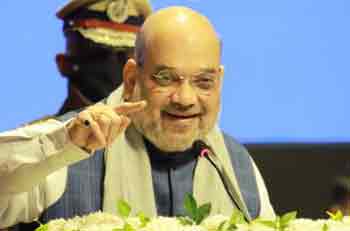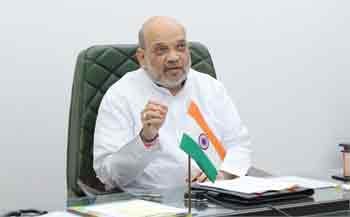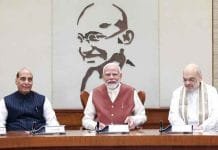In a critical National Security Meeting, Union Home Minister Amit Shah voiced deep concerns about the increasing misuse of encrypted communication platforms by terrorist organizations. As digital threats become more sophisticated, our national security apparatus must rise to meet this challenge with technological foresight, robust coordination, and uncompromising execution. The Home Minister emphasized the urgent necessity to dismantle terrorist communication networks and issued a series of concrete directives aimed at containing the growing menace of communication-addiction among extremist groups.
Encrypted Messaging Apps: The New Weapon of Terror
The proliferation of end-to-end encrypted platforms like Telegram, WhatsApp, Signal, and even lesser-known apps on the dark web has empowered terrorist outfits to communicate covertly without detection. These platforms provide anonymity, rapid dissemination of orders, and are increasingly being used to recruit operatives, share attack blueprints, and coordinate cross-border operations.
Home Minister Shah described this development as “communication-addiction”, highlighting how terror modules are becoming heavily reliant on these platforms. This addiction poses a dual threat: it allows enemies of the state to operate in stealth while simultaneously hindering traditional intelligence-gathering efforts.
Strategic Instructions from the Home Minister
To counter this evolving threat, Amit Shah issued three crucial instructions during the high-level meeting:
Creation of a Dedicated Counter-Communication Platform
Shah instructed intelligence agencies to immediately develop a centralized monitoring system that can identify, trace, and neutralize terror-related digital communication channels in real-time. This dedicated platform would integrate with existing surveillance frameworks and use AI-powered analytics to detect suspicious patterns across public and dark web communication networks.Enhanced Coordination Between Security Agencies
The Home Minister called for seamless collaboration between central and state intelligence bodies, the National Investigation Agency (NIA), and the Cyber Crime Division. This move aims to bridge intelligence gaps and ensure that actionable data is shared instantly across departments to thwart impending threats.Mechanism to Retrieve Absconding Criminals
Amit Shah stressed the need for a strong extradition framework to bring back fugitives who have escaped justice and are operating from foreign soils. He instructed legal and diplomatic departments to fast-track coordination with Interpol and strengthen bilateral treaties with countries harboring such elements.
Terrorism in the Digital Age: How Social Media is Weaponized
The advent of social media has revolutionized global communication—and with it, the operational dynamics of terrorism. Groups like Lashkar-e-Taiba, Jaish-e-Mohammed, ISIS, and others have evolved into digitally savvy networks. Their recruitment propaganda, radicalization tactics, and encrypted command chains are all rooted in cyberspace.
Intelligence agencies have identified multiple closed-group forums, online gaming platforms, and even anonymous forums being exploited for secret coordination. These groups avoid traditional calling and texting methods, making digital surveillance both critical and complex.
India’s Response: Fortifying Cyber Intelligence
In light of Amit Shah’s remarks, the Ministry of Home Affairs is working to build a new cyber-security architecture:
AI Surveillance Grids will track anomalies in communication behavior.
Quantum decryption labs will be deployed to decode encrypted channels faster.
National Cyber Coordination Centre (NCCC) will be upgraded with deep-packet inspection tools to identify illicit communications disguised within harmless data.
Joint Command Centres will be established in major metros to operate round-the-clock and handle urgent counter-communication missions.
These tools aim not just to monitor but to actively dismantle online terror networks.
Cross-Border Terror & Fugitive Recovery: The Next Frontier
A key highlight of the security briefing was the renewed focus on bringing back fugitive terrorists and criminals. Shah insisted that those who have fled Indian jurisdiction must not be allowed to operate freely from safe havens.
To accomplish this:
A “Fugitive Tracker Task Force” will be set up under the NIA to profile, locate, and coordinate the retrieval of high-value absconders.
Indian embassies abroad will appoint legal attachés specifically tasked with liaising with local law enforcement.
Diplomatic channels will be strengthened to push for deportation and legal cooperation from nations that have become hotbeds for India’s most-wanted fugitives.
Unified Intelligence Grid: One Nation, One Surveillance System
Another key recommendation by Amit Shah was the integration of intelligence frameworks under a Unified Intelligence Grid (UIG). This initiative seeks to pool information from:
The Intelligence Bureau (IB)
Research & Analysis Wing (RAW)
Defence Intelligence Agency (DIA)
National Technical Research Organisation (NTRO)
State-level intelligence units
By combining data across all security wings, the UIG will enable a centralized threat map that dynamically tracks the activities of suspected entities, both domestic and international.
Policy Reforms and Legal Backing
For these technical measures to be effective, Shah emphasized the urgent need for legislative reforms:
Amendments to the Information Technology Act to grant more powers for digital surveillance in terror cases.
Introduction of a National Anti-Terror Digital Monitoring Bill to enable pre-emptive actions against encrypted communications.
Stronger penalties for individuals found guilty of aiding, abetting, or facilitating digital terror logistics.
These reforms would empower law enforcement with legal agility to respond swiftly to emerging threats.
Public Vigilance and Awareness: A Community-Centered Approach
While the focus remains on intelligence and technology, Shah underscored the role of public awareness in combating communication-based terrorism. Citizens must be educated on:
How to report suspicious digital activity
Recognizing radical content online
The dangers of forwarding unverified links or messages
The Home Ministry will soon launch a nationwide campaign, encouraging citizens to join the movement against terror-tech proliferation under the slogan: “Report. Resist. Reclaim.”
Conclusion: A Call for a Digital Strike Against Terrorism
Amit Shah’s directives mark a paradigm shift in India’s counter-terrorism strategy—from boots on the ground to bytes in the cloud. As terrorists evolve with technology, so must our defenses. The fusion of cyber intelligence, AI-driven platforms, inter-agency coordination, and international cooperation is no longer optional—it is the only way forward.
The battlefront has changed, and India stands ready—not just to respond but to preempt. Under Shah’s leadership, the push to neutralize terror communication channels and reclaim digital spaces from extremist influence is poised to be one of the most aggressive and strategic counter-terror initiatives of the decade.














